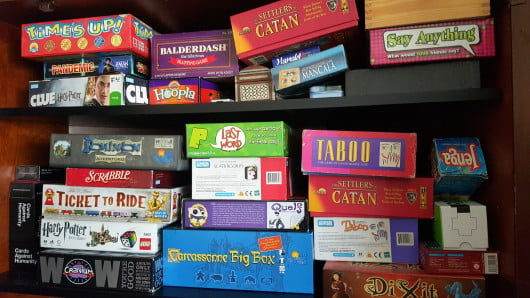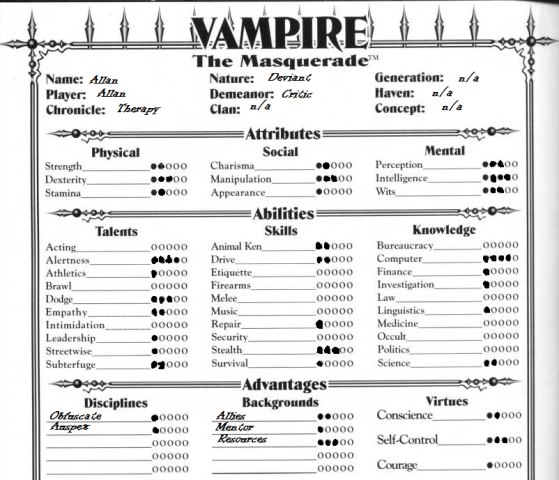This piece was originally published on the blog of Jennie Steinberg, psychotherapist. It has been republished here with permission.
The first time I ever used the concept of gaming and leveling up in a therapy session, I had never heard the word “gamification.” All I knew was that the client sitting in front of me, Allan (name changed), had the following traits:
1. was so anxious it was hard for him to leave the house,
2. had worked with other therapists unsuccessfully, and
3. loved to play tabletop roleplaying games (RPGs), such as Dungeons and Dragons and Vampire: the Masquerade.
When I’m working with a client who has had negative experiences with previous therapists, I always ask about what those therapists did. While some clients say that the previous therapist was scatterbrained, administratively disorganized, or otherwise unprofessional, most say that they felt misunderstood or judged. Allan was no different.
“She kept using terms like transference and resistance. It wasn’t that I didn’t understand what she meant—she defined the words, but it just felt like she was speaking a different language, and I felt like she just didn’t really get me.”
So after our first session, I thought about it: How could I speak Allan’s language?
I went back to the list of things I knew about this client:
1. very anxious
Okay, I’ve helped a lot of clients with anxiety. This client’s anxiety is more severe than many of the other people I’ve worked with, but overall, I’m confident in my ability to help this guy.
2. previous unsuccessful bouts of therapy
It’s pretty clear from talking to Allan about this that the previous therapist wasn’t “meeting him where he is,” as we say in the therapy world. Okay, so how can I speak this client’s language? Which brings me to …
3. loves RPGs
Hmm, what is it that draws the client to RPGs? I thought about the small amount of RPG knowledge I had obtained from conversations with friends who had this interest, and from my brief engagement in a game of Vampire: The Masquerade. What is it that would draw a very anxious person to these games?
In RPGs, you create a character by filling out a “character sheet.” That character has skills, knowledge, and assets that enable them to thrive and succeed. They also have deficit areas where they struggle. As a character completes quests, they are given Experience Points, which can be spent to improve performance areas—either to enhance an already strong skill, or to improve a weak one.
I thought about how this is analogous to the work I do with clients—they learn and uncover things about themselves, and this enables them to make improvements in various areas of their lives. This, I realized, was my key to helping this client.
I arrived at our next session with two copies of a character sheet for a game of Vampire: the Masquerade. I had the client fill out both – one for who he is and one for who he wanted to be. For context, here’s an approximation of what his “before” may have looked like:
The “after” was similar, but had more “dots” filled in for areas such as Courage, Survival, Appearance, Leadership, and Charisma. So together, we explored what it would take for this client to “level up,” and it became the framework for our sessions.
It wasn’t until later that I learned that there was a name for the work we did in these sessions.
What is gamification?
Gamification, simply, is the idea that when you turn your goals into a game, they become more fun and feel more attainable. This includes factors such as keeping score, competing with others, and defining a “win.”
A great example of this that many people may be familiar with is the Fitbit. It encourages competition with your friends, it gives you quantifiable data to tell you how you’re doing, and on some models, it vibrates when you hit your step goal to tell you that you’ve done well. A lot of people I know have used their Fitbit to encourage them to walk more and have found great health benefits.
One reason that Fitbit is so effective is that it defines your goal in easily measurable terms, so you know whether you’ve succeeded at achieving it. Some people might say their goal is to exercise more or, more specifically, to walk more. Fitbit says, “Okay, how many steps do you want to walk?” Then it rewards you with “badges” when you hit or exceed your target.
But you don’t really need any equipment to “gamify” your goals. It can be as simple as, “For every day I exercise, I’m going to give myself 10 points. When I have 100 points, I’m going to buy a new pair of pants.”
I would like to share with you two excellent examples of gamification:
Nerd Fitness: Level Up Your Life
My first actual exposure to the idea of Gamification was a website called Nerd Fitness, created by Steve Kamb. The website contains hundreds of free articles about diet, fitness, and healthy mindset, and this week, its creator released a book called Level Up Your Life. But the real gem of the site is the paid feature: the Nerd Fitness Academy.
In the Nerd Fitness Academy, you create a character with an avatar. From there, you get experience points for completing different “quests.” These can range from “bench press half your bodyweight” to “go to a session at a rock climbing gym” to “go for a 5 minute walk.” You can also create your own quests related to broader life goals, such as “visit a foreign country.”
When you complete quests, you get points—more points for more difficult quests—and when you’ve accrued a certain number of points, you “level up”. Everyone starts at a level 1, but as you work towards your goals, you can get all the way up to a level 50!
Jane McGonigall: SuperBetter
Fitness is, perhaps, an easy thing to quantify, but how about mental health and wellness?
Jane McGonigall is a game designer who suffered a traumatic brain injury. As she discusses in her compelling TED Talk, it completely debilitated her, and, she says, she wanted to die. One day, as she lay in bed thinking about ending her life, she made a decision: She was going to stop living this way. So, calling on her game design background, she made getting better a game.
She adopted a “secret identity” (Jane the Concussion Slayer), recruited allies, and created a game called SuperBetter where she got points for doing things proven to help her feel better. Points were given for self-care activities targeting her mind, body, spirit, and relationships, and slowly, she noticed that she felt less depressed. When she started blogging about this, she was amazed that other people living with health problems jumped on board and reported that they, too, saw great results.
She has also written a book about this, and you can play the game by joining on her website.
How can this help me?
Like Jane McGonigall and Steve Kamb, you probably have things in your life that you want to accomplish but have trouble getting yourself to do.
If you’ve ever crossed items off a “to do” list, you know the satisfaction of marking your achievements. That’s just a mindset shift from gamifying your life. If you think, “If I check off all the items on this list, I win today!” that feels very different than, “Ugh, I have so much to do. This sucks. Well, I guess I’ll start on all this drudgery.”
With gamification, you can work towards your goals with less stress and annoyance, and with more potential for success!
Jennie Steinberg, LMFT, LPCC is a strength-based psychotherapist practicing in Downtown Los Angeles. She loves working with clients who are on identity journeys, working to live authentically, make major life decisions, and build their self-esteem. You can visit her website to make an appointment or read more articles she has written at http://www.jenniesteinberg.com
—Please make note of The Mary Sue’s general comment policy.—
Do you follow The Mary Sue on Twitter, Facebook, Tumblr, Pinterest, & Google +?









